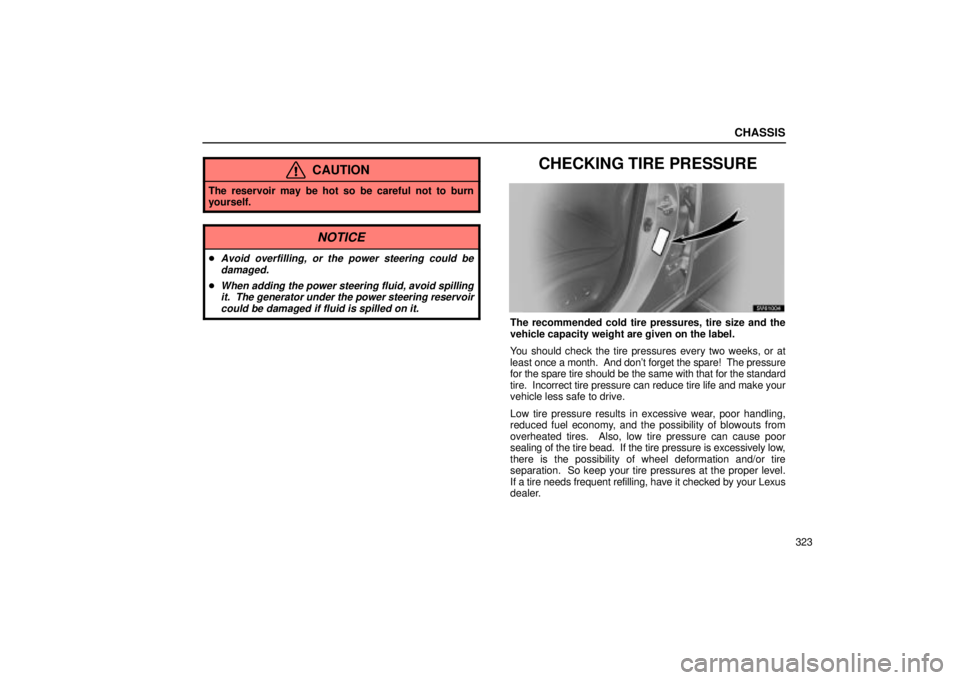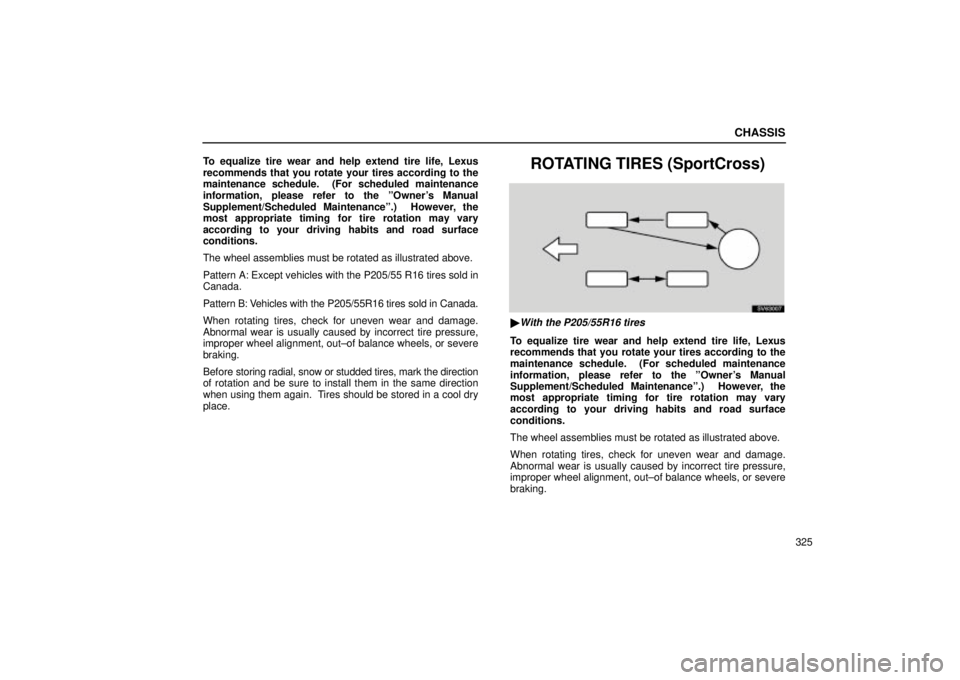Page 333 of 378
CHASSIS
320± TIRES AND WHEELS (Type C)
Standard tires
Tire size
Tire inflation pressure Recommended cold tire inflation pressure
Wheel size
Wheel nut torque
Compact spare tire (IS300 sold in Canada only)
Tire size
Tire inflation pressure
Wheel size
Wheel nut torque
P205/55R16 89V
Front 230 kPa (2.3 kgf/cm2 or bar, 33 psi)
Rear 230 kPa (2.3 kgf/cm2 or bar, 33 psi)
For sustained high speeds above 160 km/h (100 mph), in
countries where such speeds are permitted by law, add 70
kPa (0.8 kgf/cm
2, 0.7 bar, 10 psi) to the front tires and rear
tires, but never exceed the maximum cold tire pressure
molded on the tire sidewall.
16 x 6 1/2JJ
103 N´m (10.5 kgf´m, 76 ft´lbf.)
T125/70D17 98M
420 kPa (4.2 kgf/cm
2 or bar, 60 psi)
17 x 4T
103 N´m (10.5 kgf´m, 76 ft´lbf.)
NOTE: For complete information on tires (e.g. replacing tires or replacing wheels\
), see ºChecking tire pressureº through ºAluminum
wheel precautionsº on page 323 through 332.
Page 336 of 378

CHASSIS
323
CAUTION
The reservoir may be hot so be careful not to burn
yourself.
NOTICE
�Avoid overfilling, or the power steering could bedamaged.
�When adding the power steering fluid, avoid spillingit. The generator under the power steering reservoircould be damaged if fluid is spilled on it.
CHECKING TIRE PRESSURE
SV61004
The recommended cold tire pressures, tire size and the
vehicle capacity weight are given on the label.
You should check the tire pressures every two weeks, or at
least once a month. And don't forget the spare! The pressure
for the spare tire should be the same with that for the standard
tire. Incorrect tire pressure can reduce tire life and make your
vehicle less safe to drive.
Low tire pressure results in excessive wear, poor handling,
reduced fuel economy, and the possibility of blowouts from
overheated tires. Also, low tire pressure can cause poor
sealing of the tire bead. If the tire pressure is excessively low,
there is the possibility of wheel deformation and/or tire
separation. So keep your tire pressures at the proper level.
If a tire needs frequent refilling, have it checked by your Lexus
dealer.
Page 337 of 378

CHASSIS
324High tire pressure produces a harsh ride, handling problems,
excessive wear at the center of the tire tread, and a greater
possibility of tire damage from road hazards.
The following instructions for checking tire pressure should be
observed:
�
The pressure should be checked only when the tires are
cold. If your vehicle has been parked for at least 3 hours
and has not been driven for more than 1.5 km or 1 mile
since, you will get an accurate cold tire pressure reading.
� Always use a tire pressure gauge. The appearance of the
tire can be misleading. Besides, tire pressures that are
even just a few pounds off can degrade ride and handling.
� Do not bleed or reduce tire pressure after driving. It is
normal for the tire pressure to be higher after driving.
� Never exceed the vehicle capacity weight. The
passengers and luggage weight should be located so that
the vehicle is balanced.
� Be sure to reinstall the tire valve caps. Without the valve
caps, dirt or moisture could get into the valve core and
cause air leakage. If the caps have been lost, have new
ones put on as soon as possible.
ROTATING TIRES (Sedan)
SV63007
�Pattern A
SV63008
�Pattern B
Page 338 of 378

CHASSIS
325
To equalize tire wear and help extend tire life, Lexus
recommends that you rotate your tires according to the
maintenance schedule. (For scheduled maintenance
information, please refer to the ºOwner's Manual
Supplement/Scheduled Maintenanceº.) However, the
most appropriate timing for tire rotation may vary
according to your driving habits and road surface
conditions.
The wheel assemblies must be rotated as illustrated above.
Pattern A: Except vehicles with the P205/55 R16 tires sold in
Canada.
Pattern B: Vehicles with the P205/55R16 tires sold in Canada.
When rotating tires, check for uneven wear and damage.
Abnormal wear is usually caused by incorrect tire pressure,
improper wheel alignment, out±of balance wheels, or severe
braking.
Before
storing radial, snow or studded tires, mark the direction
of rotation and be sure to install them in the same direction
when using them again. Tires should be stored in a cool dry
place.
ROTATING TIRES (SportCross)
SV63007
�With the P205/55R16 tires
To equalize tire wear and help extend tire life, Lexus
recommends that you rotate your tires according to the
maintenance schedule. (For scheduled maintenance
information, please refer to the ºOwner's Manual
Supplement/Scheduled Maintenanceº.) However, the
most appropriate timing for tire rotation may vary
according to your driving habits and road surface
conditions.
The wheel assemblies must be rotated as illustrated above.
When rotating tires, check for uneven wear and damage.
Abnormal wear is usually caused by incorrect tire pressure,
improper wheel alignment, out±of balance wheels, or severe
braking.
Page 376 of 378

3
GAS STATION INFORMATION
�Fuel selection:
Select premium unleaded gasoline with an Octane Rat-
ing of 91 (Research Octane Number 96) or higher for
optimum engine performance. However, if such pre-
mium type cannot be obtained, you may temporarily use
unleaded gasoline with an Octane Rating as low as 87
(Research Octane Number 91).
� Fuel tank capacity:
66 L (17.5 gal., 14.5 lmp.gal.)
� Engine oil:
API SJ, ºEnergy±Conservingº multigrade engine oil or
ILSAC multigrade engine oil.
Recommend oil viscosity ± SAE 5W±30 if normal
temperatures are below 38 �C (100�F)
Oil capacity: L (qt., lmp.qt.)
Drain and refill with filter 5.4 (5.7, 4.8)
without filter 5.1 (5.4, 4.5)
See page 310 for detailed information.
� Engine coolant:
Capacity: 7.5 L (7.9 qt., 6.6 lmp.qt.)
Coolant type ± ºToyota Long Life Coolantº or equivalent
With ethylene±glycol type coolant for a proper corrosion
protection of aluminum components For checking the engine coolant, see page 313.
Do not use alcohol type antifreeze or plain water alone.
� Automatic transmission:
Fluid type ± Automatic transmission fluid Type T±IV
See page 316 for detailed information.
� Tire information:
See page 323 through 332 for detailed information.
� Tire pressure:
Tire size: 225/45ZR17, 215/45ZR17 or P205/55R16 89V
Tire pressure: cold tires
kPa (kgf/cm
2 or bar, psi)
Ti
re sizeFrontRear
225/45ZR17 ± 240 (2.4, 35)
215/45ZR17 230 (2.3, 33) 230 (2.3, 33)
P205/55R16 89V 230 (2.3, 33) 230 (2.3, 33)
For sustained high speeds above 160 km/h (100 mph), in
countries where such speeds are permitted by law, add the
tire pressure given below to the front tires and rear tires, but
never exceed the maximum cold tire pressure molded on the
tire sidewall.
225/45ZR17 70kPa (0.8 kgf/cm
2, 0.7 bar, 10 psi)
215/45ZR17 70kPa (0.8 kgf/cm2, 0.7 bar, 10 psi)
P205/55R16 89V 70kPa (0.8 kgf/cm2, 0.7 bar, 10 psi)